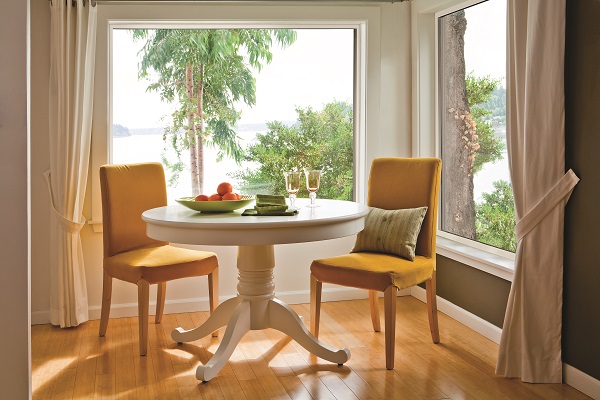Your home’s windows play a crucial role in its energy performance – acting as either a barrier against energy waste or a source of costly heat loss. Today’s energy-efficient windows do more than just beautify your home; they actively work to reduce your monthly utility bills through advanced engineering. Built with innovative features like low-emissivity glass coatings, multiple insulating panes, and high-performance frames, modern windows create a powerful thermal shield around your home. These technological improvements help maintain comfortable indoor temperatures year-round by preventing heat from escaping in winter and blocking excess solar heat in summer, making drafty rooms and high energy bills a thing of the past.
The Benefits of Energy-Efficient Windows
Energy-efficient windows represent a significant advancement in home improvement technology, offering homeowners a powerful way to reduce energy costs while enhancing comfort. These innovative windows do more than just provide a view – they actively work to maintain your home’s ideal temperature and reduce your environmental footprint. Modern energy-efficient windows employ multiple technologies to prevent heat transfer, including multiple panes of glass that create insulating air pockets, special gas fills between panes, advanced frame materials, and specialized edge spacers that work together to minimize thermal bridging.
The benefits of energy-efficient windows extend far beyond simple temperature control. Homeowners who invest in these windows typically experience reduced heating and cooling costs throughout the year, along with more consistent indoor temperatures across all rooms. This improved efficiency leads to decreased strain on HVAC systems and enhanced home comfort in all seasons. Additionally, these windows provide better sound insulation, reducing external noise penetration, while also protecting furniture and flooring from UV damage.
Low-emissivity (Low-E) coatings play a vital role in window efficiency. These microscopic layers of metallic oxide reflect heat back into your home during winter and block unwanted solar heat gain during summer, while filtering out harmful UV rays and allowing natural light to enter. When evaluating windows, look for those bearing the ENERGY STAR® certification, which indicates compliance with strict energy efficiency standards and verified performance through independent testing. These certified windows may also qualify for potential energy-efficiency rebates and incentives.
Modern energy-efficient windows typically feature double or triple-pane construction with insulating gas fills between panes. This advanced design incorporates warm-edge spacer technology and superior sealing systems to maximize energy savings. By understanding these key elements of energy-efficient windows, homeowners can make informed decisions about upgrading their homes for improved comfort and energy savings. The initial investment in quality windows often pays dividends through years of reduced energy costs and enhanced home comfort.
Potential Energy Savings
Investing in energy-efficient windows represents one of the most impactful ways to reduce your home’s energy consumption and monthly utility costs. By replacing outdated windows with modern, high-performance alternatives, homeowners can achieve substantial savings while improving their home’s comfort and value. These advanced windows work continuously to maintain optimal indoor temperatures, reducing the workload on heating and cooling systems throughout the year.
The potential energy savings from new windows can be quantified through several industry-standard measurements. The U-factor measures how well a window prevents heat from escaping, while the Solar Heat Gain Coefficient (SHGC) indicates its effectiveness at blocking unwanted solar heat. When evaluating windows for your specific climate, these ratings serve as crucial indicators of performance and potential energy savings. Local building codes and energy requirements often reference these measurements, helping homeowners select windows that will perform optimally in their region.
The ENERGY STAR program provides valuable guidance for homeowners seeking proven energy-efficient solutions. This EPA-backed certification ensures that windows meet rigorous performance standards through comprehensive testing and verification. ENERGY STAR certified windows must demonstrate significant energy-saving capabilities specific to different climate zones across the country. This certification offers homeowners confidence that their investment will deliver meaningful energy savings.
The real-world impact of energy-efficient windows extends beyond theoretical calculations. Homeowners consistently report marked decreases in their energy bills after installing high-performance windows. These savings stem from multiple factors: enhanced insulation that prevents heat loss during winter months, improved solar heat blocking during summer, and the elimination of drafts that force heating and cooling systems to work harder. The cumulative effect often results in noticeable monthly savings and a more comfortable living environment throughout the year.
Maximizing Energy Efficiency Beyond Windows
While new windows are a significant step towards increasing your home’s energy efficiency, complementary home improvements can further enhance overall energy savings. By focusing on insulation, weatherstripping, and optimizing energy usage, you can maximize the benefits of your new windows and create a more energy-efficient living space.
Insulation is a key factor in reducing energy loss and maintaining a comfortable indoor environment. Proper insulation helps regulate temperature, preventing heat from escaping during winter and entering during summer. By insulating your attic, walls, and floors, you can minimize energy waste and reduce utility bills.
Weatherstripping is another essential element in preventing energy loss. It involves sealing gaps and cracks around windows, doors, and other openings to prevent air leakage. Proper weatherstripping eliminates drafts, ensuring conditioned air stays inside, reducing the strain on your HVAC system, and saving energy.
In addition to windows, insulation, and weatherstripping, there are other ways to optimize overall energy savings. Using energy-efficient lighting, such as LED bulbs, throughout your home is a great start. These bulbs consume less electricity and have a longer lifespan, resulting in both energy and cost savings. Additionally, consider installing a programmable thermostat to regulate your home’s temperature based on your schedule, allowing you to reduce energy usage when you’re not at home or during sleeping hours.
Implementing these complementary home improvements and optimizing your energy usage goes beyond new windows to create a truly energy-efficient living space. Not only will you enjoy lower energy bills, but you’ll also contribute to a greener environment. For more information on energy-efficient windows and other home improvement solutions, contact DaBella today.
FAQs: Energy Savings After Installing New Windows
Here are some frequently asked questions about the energy savings you can expect after installing new windows:
Do new windows help keep heat out?
Absolutely! New windows are designed with advanced materials and technologies that provide better insulation and reduce heat transfer. They have multiple panes of glass with insulating gas fillings, low-emissivity coatings, and improved weatherstripping, all of which work together to keep the heat out during hot summers.
How much difference will new windows make?
The difference can be quite significant. Older windows often have single-pane glass and lack proper insulation, leading to energy loss. By installing new windows, you can experience improved thermal efficiency, reduced drafts, and better overall comfort in your home.
How much can you save by installing new windows?
The amount you can save depends on various factors such as the size of your home, your location, and the energy efficiency of the new windows. However, studies have shown that homeowners can save up to 20% on their energy bills by upgrading to energy-efficient windows. Over time, these savings can really add up.
Contact DaBella for Your Next Window Replacement Project
Transform your home’s comfort and appearance with DaBella’s premium Glasswing vinyl windows. Engineered with advanced technology and superior materials, these windows deliver exceptional energy efficiency by creating a powerful thermal barrier. The result? Your home stays cooler in summer, warmer in winter, and your energy bills stay lower all year round.
We believe your vinyl replacement windows should be as beautiful as they are functional. That’s why our Glasswing collection comes in an array of styles to complement any architectural design. Choose from classic double-hung windows that capture timeless elegance, sleek casement windows for a modern touch, or explore our other distinctive options. With customizable colors and finishes, you can create the perfect look for your home.
Ready to enhance your home’s efficiency and curb appeal? Our window experts are here to guide you through every step of the process. Contact us today at 844-DaBella today to schedule your free consultation for your next window replacement project. We’ll assess your needs, answer your questions, and help you select the ideal window solution that marries energy savings with lasting beauty.

